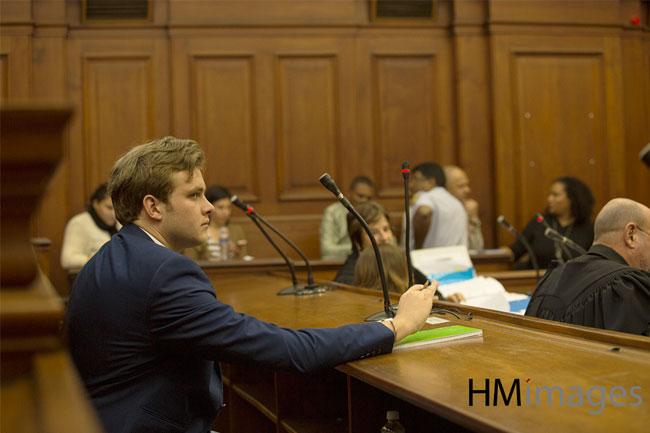On day 23 of the van Breda trial, Advocate Botha continued his cross-examination of Warrant Officer Andre Hitchcock.
Mr. Hitchcock was responsible for documenting the crime scene before processing and collecting evidence from it. His method would be to first take photographs of the scene, both inside and outside the house, then a 360-degree video – only then would he and another officer process & collect evidence from the scene and send to the SAPS forensic laboratory in Plattekloof for forensic analysis.
We heard his detailed undertaking that took place at the van Breda crime scene, where he revealed that he had spent approximately 3 working weeks collecting evidence. First Mr. Hitchcock would walk around the scene alone, then take photographs outside the home, noting possible points of entry and then photographs from inside the home.
He also took a video of the scene to record what everything looked like prior to collecting evidence.
His testimony declared that the photographs and video were taken by him and he would not be accompanied by anyone until he started processing evidence. In cross-examination, however, a photo taken by Hitchcock himself from the outside of the house, displayed Captain Joubert also taking photographs inside the home. Owing to this, it is likely that the defence is to take issue with Joubert being in the house before photographs were taken inside by Hitchcock.
Adv B shows photo 7 you can see that someone is walking through the house? [or walked through will clarify this] #vanbreda
— Tracey Stewart (@Traceyams) June 7, 2017
DNA touch evidence has been taken from the scene. These areas included handles of the open drawers in the study, as well as the handles of open cupboards. The witness confirmed that this evidence was taken to identify if an intruder had left DNA on the handles. These samples were sent to the laboratory for testing but Mr. Hitchcock was unsure about what the results of those tests were – Advocate Botha confirmed the defence had not been given the results of those tests.
There has been no explanation, to date, from the state why they haven’t entered these results into discovery.
DNA touch evidence was also taken from the knife. Mr. Hitchcock told the court that he had placed this weapon on a bed before performing this test. Advocate Botha then put it to Hitchcock that due to the sensitivity of a DNA touch test, placing the knife on the bed may very well have transferred touch DNA from the bed to the knife – a possibility which Hitchcock could not comment on.
The experts will need to deal with the prospect of compromised DNA touch evidence lifted from the knife.
B: was the blood on both sides of the blade? Which side did you swab? H: I am not sure which side I swabbed or if there was blood #vanbreda
— Tracey Stewart (@Traceyams) June 7, 2017
Advocate Botha then went through a number of samples Hitchcock had collected, being evidence collection kits (photographs of the samples and kits, as well as handwritten notes made by Hitchcock). It was disclosed that through the collection process a number of samples had been incorrectly numbered. Hitchcock conceded numbering and/or typing errors but overall these seemed to be identified and remedied through the various mechanisms he had used to record his collection of evidence.
During proceedings, Judge Desai made an interesting note. He accepted that there will be a missed photo in hundreds of photos taken in the collection of evidence but it needn’t be used as a point because it ‘sounds nice’. Both himself, and his assessor, are well equipped to comprehend the issues surrounding this factor and understand the appropriate weight to attach to evidence in light of this.
I believe Hitchcock was a credible witness although he admitted to making a few mistakes in documenting the process. We’ll learn how this develops once other experts provide their testimony regarding the evidence.
Judge Desai – a great deal of photos were taken the mere fact that 1 wasn’t taken is not a point. This is not a jury trial #vanbreda
— Tracey Stewart (@Traceyams) June 7, 2017
Near the end of the day Advocate Galloway asked to hand up a section 212(4) statement from Warrant Officer Nel, which dealt with blood specimen analysis. Advocate Botha advised the court that whilst they have to accept the statement on face value as a section 212 statement, he requested that Judge Desai use the discretion afforded to him by section 212 of the Criminal Procedure Act to call Warrant Officer Nel, as the defence wanted to test her evidence.
Advocate Botha indicated that in the report, Warrant Officer Nel makes a number of presumptive findings but doesn’t describe the processes used at all – which is why they want to test her report.
Advocate Galloway said that the state did intend to call the DNA expert and this would presumably explain what Warrant Officer Nel used to reach her conclusions. Judge Desai accepted the 212 statement and requested Advocate Botha to prepare an application, for Judge Desai to consider before he would rule on the issue of whether or not Warrant Officer Nel should be called to testify.
Desai- must the court call her why can’t you call her? B- then I can’t cross examine her #vanbreda
— Tracey Stewart (@Traceyams) June 7, 2017
Advocate Galloway asked for some time to consult before starting her re-examination of Hitchcock, who is not quite done yet, so we will return to the Cape High Court tomorrow morning at 10am to finalise Hitchcock’s evidence. Whereafter, we hope to hear from some forensic experts regarding the results of the evidence collected, but we may first need to hear from other investigating officers on the scene including Captain Joubert (who was seen photographing the scene in Hitchcock’s pictures).
Follow me on Twitter for live, to-the-minute updates tomorrow at day 24 of the van Breda trial.
Photography K-leigh Siebritz






